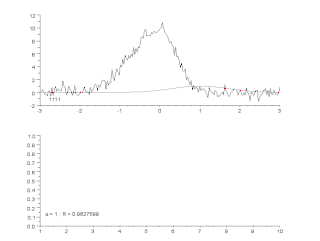Related Research Articles

Microeconomics is a branch of economics that studies the behavior of individuals and firms in making decisions regarding the allocation of scarce resources and the interactions among these individuals and firms.
A relational database is a digital database based on the relational model of data, as proposed by E. F. Codd in 1970. A software system used to maintain relational databases is a relational database management system (RDBMS). Many relational database systems have an option of using the SQL for querying and maintaining the database.

In computer science, a search algorithm is any algorithm which solves the search problem, namely, to retrieve information stored within some data structure, or calculated in the search space of a problem domain, either with discrete or continuous values. Specific applications of search algorithms include:
A topic map is a standard for the representation and interchange of knowledge, with an emphasis on the findability of information. Topic maps were originally developed in the late 1990s as a way to represent back-of-the-book index structures so that multiple indexes from different sources could be merged. However, the developers quickly realized that with a little additional generalization, they could create a meta-model with potentially far wider application. The ISO standard is formally known as ISO/IEC 13250:2003.
Constraint programming (CP) is a paradigm for solving combinatorial problems that draws on a wide range of techniques from artificial intelligence, computer science, and operations research. In constraint programming, users declaratively state the constraints on the feasible solutions for a set of decision variables. Constraints differ from the common primitives of imperative programming languages in that they do not specify a step or sequence of steps to execute, but rather the properties of a solution to be found. In additions to constraints, users also need to specify a method to solve these constraints. This typically draws upon standard methods like chronological backtracking and constraint propagation, but may use customized code like a problem specific branching heuristic.

Eliyahu Moshe Goldratt was an Israeli business management guru. He was the originator of the Optimized Production Technique, the Theory of Constraints (TOC), the Thinking Processes, Drum-Buffer-Rope, Critical Chain Project Management (CCPM) and other TOC derived tools.
The theory of constraints (TOC) is a management paradigm that views any manageable system as being limited in achieving more of its goals by a very small number of constraints. There is always at least one constraint, and TOC uses a focusing process to identify the constraint and restructure the rest of the organization around it. TOC adopts the common idiom "a chain is no stronger than its weakest link". This means that processes, organizations, etc., are vulnerable because the weakest person or part can always damage or break them or at least adversely affect the outcome.
Constraint satisfaction problems (CSPs) are mathematical questions defined as a set of objects whose state must satisfy a number of constraints or limitations. CSPs represent the entities in a problem as a homogeneous collection of finite constraints over variables, which is solved by constraint satisfaction methods. CSPs are the subject of intense research in both artificial intelligence and operations research, since the regularity in their formulation provides a common basis to analyze and solve problems of many seemingly unrelated families. CSPs often exhibit high complexity, requiring a combination of heuristics and combinatorial search methods to be solved in a reasonable time. Constraint Programming (CP) is the field of research that specifically focuses on tackling with this kind of problems. Additionally, boolean satisfiability problem (SAT), the satisfiability modulo theories (SMT), mixed integer programming (MIP) and answer set programming (ASP) are all fields of research focusing on the resolution of particular forms of the constraint satisfaction problem.

Curve fitting is the process of constructing a curve, or mathematical function, that has the best fit to a series of data points, possibly subject to constraints. Curve fitting can involve either interpolation, where an exact fit to the data is required, or smoothing, in which a "smooth" function is constructed that approximately fits the data. A related topic is regression analysis, which focuses more on questions of statistical inference such as how much uncertainty is present in a curve that is fit to data observed with random errors. Fitted curves can be used as an aid for data visualization, to infer values of a function where no data are available, and to summarize the relationships among two or more variables. Extrapolation refers to the use of a fitted curve beyond the range of the observed data, and is subject to a degree of uncertainty since it may reflect the method used to construct the curve as much as it reflects the observed data.
In graph theory, a flow network is a directed graph where each edge has a capacity and each edge receives a flow. The amount of flow on an edge cannot exceed the capacity of the edge. Often in operations research, a directed graph is called a network, the vertices are called nodes and the edges are called arcs. A flow must satisfy the restriction that the amount of flow into a node equals the amount of flow out of it, unless it is a source, which has only outgoing flow, or sink, which has only incoming flow. A network can be used to model traffic in a computer network, circulation with demands, fluids in pipes, currents in an electrical circuit, or anything similar in which something travels through a network of nodes.
Representational state transfer (REST) is a software architectural style that defines a set of constraints to be used for creating Web services. Web services that conform to the REST architectural style, called RESTful Web services, provide interoperability between computer systems on the internet. RESTful Web services allow the requesting systems to access and manipulate textual representations of Web resources by using a uniform and predefined set of stateless operations. Other kinds of Web services, such as SOAP Web services, expose their own arbitrary sets of operations.
In computer science, data validation is the process of ensuring data has undergone data cleansing to ensure they have data quality, that is, that they are both correct and useful. It uses routines, often called "validation rules", "validation constraints", or "check routines", that check for correctness, meaningfulness, and security of data that are input to the system. The rules may be implemented through the automated facilities of a data dictionary, or by the inclusion of explicit application program validation logic of the computer and its application.
In many disciplines a greenfield project is one that lacks constraints imposed by prior work. The analogy is to that of construction on greenfield land where there is no need to work within the constraints of existing buildings or infrastructure.
In physics, the degrees of freedom (DOF) of a mechanical system is the number of independent parameters that define its configuration or state. It is important in the analysis of systems of bodies in mechanical engineering, structural engineering, aerospace engineering, robotics, and other fields.
In VLSI semiconductor manufacturing, the process of Design Closure is a part of the development workflow by which an integrated circuit design is modified from its initial description to meet a growing list of design constraints and objectives.
In probability theory and in particular in information theory, total correlation is one of several generalizations of the mutual information. It is also known as the multivariate constraint or multiinformation. It quantifies the redundancy or dependency among a set of n random variables.

The merit order is a way of ranking available sources of energy, especially electrical generation, based on ascending order of price and sometimes pollution, together with amount of energy that will be generated. In a centralized management, the ranking is so that those with the lowest marginal costs are the first ones to be brought online to meet demand, and the plants with the highest marginal costs are the last to be brought on line. Dispatching generation in this way, known as "economic dispatch", minimizes the cost of production of electricity. Sometimes generating units must be started out of merit order, due to transmission congestion, system reliability or other reasons.

Lagrangian mechanics is a reformulation of classical mechanics, introduced by the Italian-French mathematician and astronomer Joseph-Louis Lagrange in 1788.
The Primetime Emmy Award for Outstanding Hosted Nonfiction Series or Special is handed out annually at the Creative Arts Emmy Award ceremony. The award was called Outstanding Informational Series or Special from 2013 until 2019, and was also presented from 1978 to 1998. From 1998 until 2012, informational series competed in Outstanding Nonfiction Series.

I Am a Singer(season 2), is the second season of the Chinese TV series I Am a Singer produced by Hunan TV, produced by Hong Tao, and the show's music director is Kubert Leung.
References
- ↑ Garner W R (1962). Uncertainty and Structure as Psychological Concepts, John Wiley & Sons, New York.
| This statistics-related article is a stub. You can help Wikipedia by expanding it. |
| This computer science article is a stub. You can help Wikipedia by expanding it. |